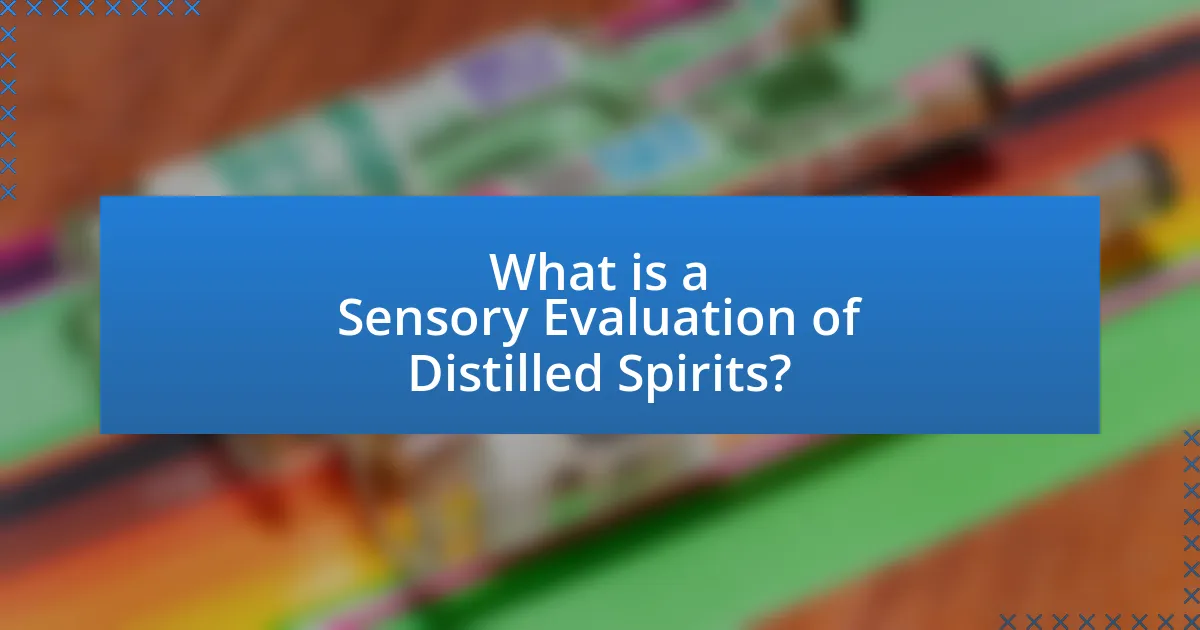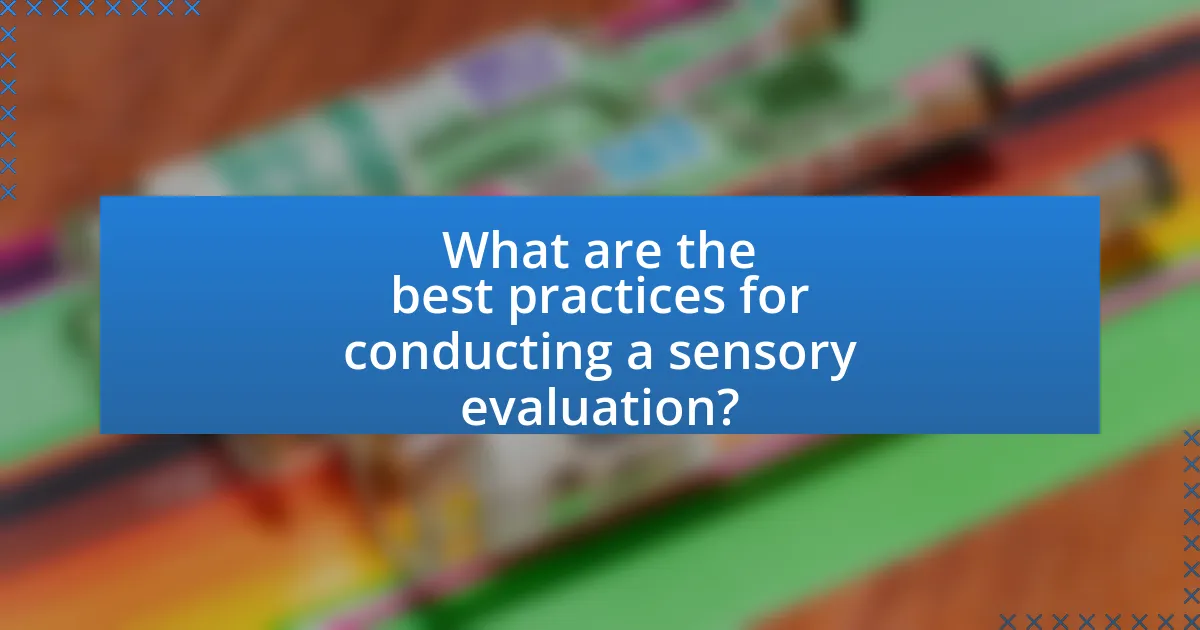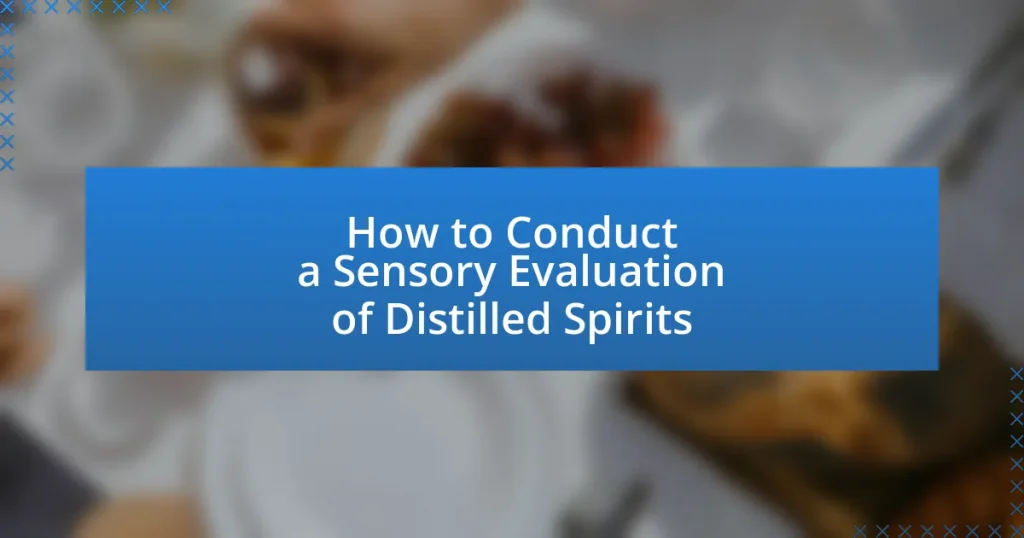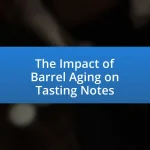A sensory evaluation of distilled spirits is a systematic process that assesses the flavors, aromas, and overall quality of alcoholic beverages using human senses. This article outlines the definition, objectives, and importance of sensory evaluation in the spirits industry, highlighting methodologies such as descriptive analysis and discrimination tests. It discusses the key components of sensory evaluation, including the five senses and the sensory attributes assessed, as well as best practices for conducting evaluations, such as creating a controlled environment and selecting appropriate samples. Additionally, the article addresses common challenges and strategies to mitigate bias, ensuring reliable and valid results in the assessment of distilled spirits.

What is a Sensory Evaluation of Distilled Spirits?
A sensory evaluation of distilled spirits is a systematic process used to assess the flavors, aromas, and overall quality of alcoholic beverages. This evaluation typically involves trained panels or consumers who utilize their senses—sight, smell, taste, and sometimes touch—to provide feedback on various attributes such as appearance, aroma, taste, mouthfeel, and aftertaste. Research indicates that sensory evaluations can significantly influence consumer preferences and market trends, as they provide objective data that can guide product development and quality control in the spirits industry.
How is sensory evaluation defined in the context of distilled spirits?
Sensory evaluation in the context of distilled spirits is defined as a systematic approach to assessing the sensory characteristics of these beverages, including aroma, taste, mouthfeel, and appearance. This evaluation is conducted using human senses to gather data on the quality and consumer preferences of distilled spirits, which can influence production and marketing strategies. Research indicates that sensory evaluation plays a crucial role in product development and quality control within the spirits industry, ensuring that products meet consumer expectations and regulatory standards.
What are the key objectives of conducting a sensory evaluation?
The key objectives of conducting a sensory evaluation are to assess the sensory attributes of a product, determine consumer preferences, and ensure quality control. Sensory evaluation aims to provide objective data on taste, aroma, appearance, and texture, which are critical for product development and improvement. For instance, studies have shown that sensory evaluations can significantly influence consumer acceptance and market success, as they help identify desirable characteristics in distilled spirits, such as flavor profiles and aroma intensity.
Why is sensory evaluation important for distilled spirits?
Sensory evaluation is important for distilled spirits because it assesses the quality, flavor, aroma, and overall consumer experience of the product. This evaluation helps producers identify desirable characteristics and improve their offerings based on consumer preferences. Research indicates that sensory analysis can significantly influence consumer purchasing decisions, as taste and aroma are critical factors in the enjoyment of distilled spirits. For example, a study published in the Journal of Food Science found that sensory attributes directly correlate with consumer satisfaction and brand loyalty in alcoholic beverages.
What are the main components of sensory evaluation?
The main components of sensory evaluation are the sensory modalities, which include sight, smell, taste, touch, and hearing. Each modality plays a crucial role in assessing the overall quality and characteristics of a product, such as distilled spirits. For instance, sight evaluates color and clarity, smell assesses aroma and bouquet, taste measures flavor profiles, touch considers texture and mouthfeel, and hearing can relate to the sound of pouring or carbonation. These components collectively contribute to a comprehensive sensory profile, enabling evaluators to make informed judgments about the product’s quality and appeal.
What sensory attributes are assessed during the evaluation?
The sensory attributes assessed during the evaluation of distilled spirits include appearance, aroma, taste, mouthfeel, and finish. Appearance involves evaluating color and clarity, while aroma focuses on the scents perceived when the spirit is swirled and inhaled. Taste encompasses the basic flavors such as sweetness, bitterness, sourness, and saltiness, alongside the complexity of flavor profiles. Mouthfeel assesses the texture and body of the spirit, and finish refers to the aftertaste and lingering sensations post-consumption. These attributes are critical for a comprehensive sensory evaluation, as they provide insights into the quality and characteristics of the distilled spirits being assessed.
How do the five senses contribute to the evaluation process?
The five senses—sight, smell, taste, touch, and hearing—play a crucial role in the evaluation process of distilled spirits. Sight allows evaluators to assess color, clarity, and viscosity, which can indicate quality and age. Smell is essential for identifying aromas and nuances, as the olfactory system can detect a wide range of compounds that contribute to the spirit’s character. Taste provides direct feedback on flavor profiles, sweetness, bitterness, and overall balance, which are critical for determining the spirit’s appeal. Touch, through mouthfeel, influences perceptions of texture and warmth, affecting the overall drinking experience. Hearing, while less prominent, can contribute to the evaluation through the sounds associated with pouring and tasting, which can evoke expectations and enhance the sensory experience. Together, these senses provide a comprehensive framework for assessing the quality and characteristics of distilled spirits.
What methodologies are used in sensory evaluation?
The methodologies used in sensory evaluation include descriptive analysis, discrimination tests, and affective testing. Descriptive analysis involves trained panels that provide detailed descriptions of sensory attributes, while discrimination tests, such as triangle tests or duo-trio tests, assess whether differences exist between products. Affective testing measures consumer preferences and acceptability through methods like hedonic scaling. These methodologies are widely recognized in sensory science for their effectiveness in evaluating products, including distilled spirits, ensuring reliable and valid results in sensory assessments.
What are the different types of sensory evaluation methods?
The different types of sensory evaluation methods include discrimination tests, descriptive analysis, and affective tests. Discrimination tests, such as triangle tests and duo-trio tests, assess whether a difference exists between samples. Descriptive analysis involves trained panels that provide detailed descriptions of sensory attributes, often using scales to quantify perceptions. Affective tests, like hedonic scaling, measure consumer preferences and acceptability. These methods are widely recognized in sensory science for their ability to provide reliable and valid data on sensory characteristics and consumer responses.
How do trained panels differ from consumer panels in evaluations?
Trained panels differ from consumer panels in evaluations primarily in their expertise and the criteria used for assessment. Trained panels consist of individuals who have undergone specific training to identify and evaluate sensory attributes with precision, often using standardized methods and terminology. In contrast, consumer panels comprise untrained individuals who provide feedback based on personal preferences and subjective experiences without formal sensory evaluation training. Research indicates that trained panels yield more consistent and reliable results due to their ability to discern subtle differences in products, which is critical in sensory evaluations of distilled spirits.

How do you prepare for a sensory evaluation of distilled spirits?
To prepare for a sensory evaluation of distilled spirits, ensure that the evaluation environment is neutral, free from strong odors, and well-lit. This setup minimizes external influences on the sensory experience. Additionally, select appropriate glassware, such as tulip-shaped glasses, which concentrate aromas and enhance the tasting experience. It is also essential to provide palate cleansers, like water or plain crackers, to refresh tasters’ palates between samples. Research indicates that sensory evaluations are more accurate when conducted in controlled environments, as outlined in studies on sensory analysis methodologies.
What steps should be taken to set up the evaluation environment?
To set up the evaluation environment for a sensory evaluation of distilled spirits, first ensure that the location is quiet, well-lit, and free from distractions. This environment should have controlled temperature and humidity to prevent any influence on the sensory attributes of the spirits. Next, provide appropriate glassware, such as tulip-shaped glasses, which enhance the aroma and visual assessment of the spirits. Additionally, arrange for neutral tasting materials, like water and plain crackers, to cleanse the palate between samples. Finally, establish a systematic approach for presenting the spirits, such as randomizing the order of samples to minimize bias. These steps are essential for obtaining reliable and valid sensory data.
How does lighting and temperature affect the evaluation?
Lighting and temperature significantly influence the sensory evaluation of distilled spirits by affecting the perception of color, aroma, and taste. Proper lighting enhances the visibility of the spirit’s color, which is crucial for assessing quality, as color can indicate age and flavor profile. For instance, natural daylight is often preferred for evaluations because it provides a true representation of color without distortion. Temperature impacts the volatility of aromatic compounds; warmer temperatures can enhance aroma release, making it easier for evaluators to detect subtle notes. Research indicates that serving spirits at optimal temperatures, typically between 15-20 degrees Celsius, maximizes flavor perception and overall enjoyment. Therefore, both lighting and temperature are essential factors in conducting accurate sensory evaluations of distilled spirits.
What materials and equipment are necessary for the evaluation?
The materials and equipment necessary for the evaluation of distilled spirits include standardized tasting glasses, a controlled environment for sensory assessment, and a scoring sheet for recording observations. Standardized tasting glasses, such as tulip-shaped glasses, enhance the aroma and flavor perception, which is critical in sensory evaluation. A controlled environment minimizes external influences, ensuring that factors like lighting and temperature do not affect the evaluation. The scoring sheet allows evaluators to systematically record their sensory impressions, facilitating accurate comparisons and analyses.
How do you select the distilled spirits for evaluation?
To select distilled spirits for evaluation, one must consider factors such as the type of spirit, production methods, and sensory characteristics. The selection process typically involves identifying a diverse range of spirits that represent various styles, regions, and production techniques, ensuring a comprehensive evaluation. For instance, including spirits from different countries, such as Scotch whisky, American bourbon, and artisanal gin, allows for a broader understanding of flavor profiles and production nuances. This approach is supported by industry standards that emphasize the importance of variety in sensory evaluations to capture a wide spectrum of sensory experiences.
What criteria should be used to choose the spirits?
The criteria to choose spirits for sensory evaluation include aroma, flavor, mouthfeel, appearance, and finish. Aroma is assessed by identifying the various scents present, which can indicate the quality and complexity of the spirit. Flavor encompasses the taste profile, including sweetness, bitterness, and acidity, which contribute to the overall experience. Mouthfeel refers to the texture and weight of the spirit on the palate, influencing the perception of quality. Appearance involves evaluating color and clarity, which can reflect production methods and aging processes. Finally, the finish is the aftertaste that lingers, providing insight into the spirit’s balance and depth. These criteria are essential for a comprehensive sensory evaluation, as they allow for a systematic assessment of the spirit’s characteristics.
How does the selection process impact the evaluation results?
The selection process significantly impacts evaluation results by determining the quality and characteristics of the samples being assessed. A well-defined selection process ensures that only representative and high-quality distilled spirits are included, which directly influences the sensory attributes perceived by evaluators. For instance, if the selection criteria prioritize spirits with distinct flavor profiles, the evaluation results will reflect those specific characteristics, leading to more accurate and relevant assessments. Research indicates that sample quality can affect sensory evaluation outcomes, as demonstrated in studies where variations in sample selection led to differing sensory perceptions among participants.

What are the best practices for conducting a sensory evaluation?
The best practices for conducting a sensory evaluation include selecting a suitable environment, using trained panelists, and employing standardized protocols. A controlled environment minimizes external influences, ensuring that sensory attributes are accurately assessed. Trained panelists provide reliable and consistent evaluations, as they are familiar with the sensory characteristics of the products being tested. Standardized protocols, such as using specific tasting methods and scoring systems, enhance the reliability of the results. Research indicates that these practices lead to more valid and reproducible sensory data, which is crucial for quality assessment in distilled spirits.
How should the evaluation session be structured?
The evaluation session should be structured in a systematic manner that includes preparation, execution, and analysis phases. During the preparation phase, select a controlled environment, ensure proper glassware, and provide a standardized sample of the distilled spirits. In the execution phase, participants should evaluate the spirits based on predefined sensory attributes such as aroma, taste, and mouthfeel, using a scoring system for consistency. Finally, in the analysis phase, gather and interpret the data to identify trends and preferences among the evaluated spirits. This structured approach enhances the reliability and validity of the sensory evaluation, as supported by established sensory analysis methodologies in food science.
What is the ideal number of samples to evaluate at one time?
The ideal number of samples to evaluate at one time is typically between 5 to 10 samples. This range allows for a comprehensive assessment without overwhelming the sensory panelists, which can lead to fatigue and decreased accuracy in evaluations. Research indicates that sensory fatigue can occur when panelists are exposed to too many samples, negatively impacting their ability to discern subtle differences in flavor and aroma. Therefore, limiting the number of samples to this range ensures that evaluations remain effective and reliable.
How can you ensure unbiased results during the evaluation?
To ensure unbiased results during the evaluation of distilled spirits, implement a double-blind testing protocol where neither the participants nor the evaluators know the identity of the samples being tested. This method minimizes the influence of preconceived notions and personal biases on the evaluation process. Research indicates that double-blind studies significantly reduce bias, as demonstrated in a study published in the Journal of Sensory Studies, which found that sensory evaluations conducted under blind conditions yielded more reliable and objective results compared to those where participants were aware of the samples.
What common challenges arise during sensory evaluations?
Common challenges during sensory evaluations include bias, variability in individual perceptions, and environmental factors. Bias can arise from preconceived notions or expectations about the product, which may skew results. Variability in individual perceptions occurs because different evaluators may interpret sensory attributes differently, leading to inconsistent data. Environmental factors, such as lighting, temperature, and noise, can also influence sensory experiences, potentially affecting the reliability of the evaluation. These challenges are documented in sensory science literature, emphasizing the need for controlled conditions and standardized protocols to mitigate their impact.
How can environmental factors influence the evaluation outcomes?
Environmental factors can significantly influence evaluation outcomes by affecting the sensory perception of distilled spirits. Factors such as temperature, lighting, and ambient noise can alter how evaluators perceive aroma, taste, and overall quality. For instance, research indicates that higher temperatures can enhance the volatility of aromatic compounds, leading to a more intense aroma perception, while poor lighting can hinder visual assessment of color and clarity. Additionally, ambient noise can distract evaluators, impacting their focus and potentially skewing their judgments. These influences underscore the importance of controlling environmental conditions to ensure reliable and consistent evaluation results in sensory assessments.
What strategies can be employed to mitigate bias in evaluations?
To mitigate bias in evaluations, implement blind tasting methods where participants do not know the identity of the samples being evaluated. This approach reduces preconceived notions and personal biases that can influence judgment. Research indicates that blind evaluations lead to more objective assessments, as demonstrated in studies on sensory analysis, such as those published in the Journal of Sensory Studies, which highlight the effectiveness of blind tasting in reducing bias in flavor perception. Additionally, using standardized evaluation forms and training evaluators on potential biases can further enhance objectivity in the evaluation process.
What tips can enhance the sensory evaluation process?
To enhance the sensory evaluation process, it is essential to ensure a controlled environment, as external factors can significantly influence sensory perceptions. A controlled environment minimizes distractions and allows evaluators to focus on the attributes of the distilled spirits being assessed. Research indicates that factors such as lighting, temperature, and noise levels can alter sensory experiences, making it crucial to standardize these conditions for accurate evaluations. Additionally, using appropriate glassware can enhance the perception of aromas and flavors, as specific shapes can concentrate volatile compounds. Studies have shown that the right glass can improve the overall sensory experience, leading to more reliable results.
How can evaluators improve their sensory skills?
Evaluators can improve their sensory skills by engaging in regular practice and training that focuses on identifying and differentiating various sensory attributes. Structured sensory training programs, such as those offered by organizations like the American Society of Brewing Chemists, provide systematic exposure to different aromas and flavors, enhancing the ability to recognize subtle differences in distilled spirits. Additionally, participating in blind tastings and using standardized evaluation forms can help evaluators refine their sensory perception and consistency. Research indicates that repeated exposure to specific sensory stimuli significantly enhances recognition and recall abilities, making consistent practice essential for skill development.
What resources are available for further learning about sensory evaluation?
Resources for further learning about sensory evaluation include academic textbooks, online courses, and research journals. Notable textbooks such as “Sensory Evaluation Techniques” by Morten Meilgaard, Gail Vance Civille, and B. Thomas Carr provide foundational knowledge and methodologies. Online platforms like Coursera and edX offer courses on sensory science, often developed by universities. Additionally, journals such as “Food Quality and Preference” and “Journal of Sensory Studies” publish peer-reviewed research articles that explore advancements and case studies in sensory evaluation. These resources collectively enhance understanding and application of sensory evaluation techniques.


